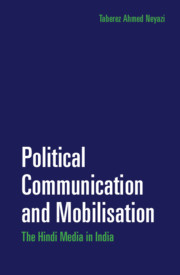Book contents
- Frontmatter
- Dedication
- Contents
- List of Figures, Tables and Maps
- Preface
- Acknowledgements
- Chapter 1 Introduction: Political Communication and Mobilisation in India
- Chapter 2 Under Colonial Rule: Mobilisation in the Hindi and English Press
- Chapter 3 Media and Mobilisation in Independent India
- Chapter 4 Localisation, Grassroots Mobilisation and Hindi News Media
- Chapter 5 Political Economy of the Hindi Press
- Chapter 6 The Hybrid Media System, Anti-corruption Movement and Political Mobilisation
- Chapter 7 Agenda-setting and Mobilisation in a Hybrid Media Environment
- Chapter 8 Conclusion: Politics, Power and Mobilisation in Digital India
- Bibliography
- Index
Chapter 4 - Localisation, Grassroots Mobilisation and Hindi News Media
Published online by Cambridge University Press: 17 August 2019
- Frontmatter
- Dedication
- Contents
- List of Figures, Tables and Maps
- Preface
- Acknowledgements
- Chapter 1 Introduction: Political Communication and Mobilisation in India
- Chapter 2 Under Colonial Rule: Mobilisation in the Hindi and English Press
- Chapter 3 Media and Mobilisation in Independent India
- Chapter 4 Localisation, Grassroots Mobilisation and Hindi News Media
- Chapter 5 Political Economy of the Hindi Press
- Chapter 6 The Hybrid Media System, Anti-corruption Movement and Political Mobilisation
- Chapter 7 Agenda-setting and Mobilisation in a Hybrid Media Environment
- Chapter 8 Conclusion: Politics, Power and Mobilisation in Digital India
- Bibliography
- Index
Summary
Mobilisation is an important indicator of citizens’ participation. With globalisation, the transformation in the nature of party politics and the increasing importance of non-party politics has facilitated the emergence of the new space for mobilisation. This new space is often visible in mediated grassroots mobilisation that is marked by the participation of multiple actors trying to communicate and influence public opinion while pitching their own demands. India has witnessed rising grassroots mobilisation since the 1980s along with an explosion of identities – caste, regional and religious. The decadeslong political control of the national political party, the Congress, at the centre and various states started to decline. Scholars writing on Indian politics began to pay great attention to these disruptive transformations particularly castebased mobilisation (Chandra, 2004; Hasan, 2000; Jaffrelot and Kumar, 2009; Varshney, 2000; Yadav 2000), the rise of Hindu nationalism (Hansen, 1999; Hansen and Jaffrelot, 1998; Jaffrelot, 1993; Rajagopal, 2001; Thachil, 2014; Varshney, 1993) and regionalism (Baruah, 1999; Singh, 2000; Subramanian, 1999). These scholarly analyses certainly expanded our understanding of chaotic transformations. Yet, with the exception of Rajagopal (2001), most of these studies largely ignored the role played by the media in these transformations.
Writing on India, Rajagopal (2001) has demonstrated how Hindutva politics took advantage of television to expand its mass base. Other studies in the Indian context, though not focusing on media alone, have found that newspapers can deliberately misinform citizens and actually serve to instigate conflicts among communities. Hallin and Mancini (2004) show that in the West too, the newspapers play many different roles, often beyond just the ‘liberal’ function of providing neutral information. In some Western media systems, newspapers represent organised social groups or serve as tools for intervention by the elite.
This chapter analyses the role of localisation of Hindi newspapers in grassroots mobilisation that provided an opportunity to vast numbers of the heterogeneous Hindi-speaking public from big and small towns, and rural areas to connect with each other and the world outside. By providing appealing, customised news to local societies, Hindi newspapers expanded their reach into the hinterland, and simultaneously created a space for marginalised groups to raise their grievances in the public arena. Interestingly, the study of localisation also shows the manifestation of three dominant forces in Indian politics – Hindutva, regionalism and caste politics – in more nuanced and complex ways.
- Type
- Chapter
- Information
- Political Communication and MobilisationThe Hindi Media in India, pp. 77 - 102Publisher: Cambridge University PressPrint publication year: 2017



